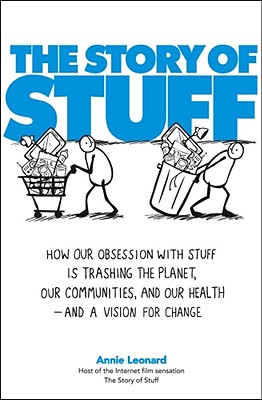The Story of Stuff: How Our Obsession with Stuff is Trashing the Planet, Our Communities, and our Health—and a Vision for Change
Annie Leonard

I had hesitated to read this book because I had already watched AL’s “Story of Stuff” video online, and thought maybe it would be redundant. But I’m glad I checked it out! Although it covers a lot of the same ground, there is plenty of interesting stuff in it.
In this book, AL talks about so many different things in our lives that are bad for the environment that it can be a little overwhelming. During the early parts of the book I kept having the feeling that I wanted her to triage it a little, tell me which things were the worst that I should focus on not getting/using. But later in the book, I came to appreciate that she didn’t do this. It became clear that this was to some extent intentional. AL makes it clear that she does not think we can shop our way to ecotopia. The true message is that the catalog of environmental horrors really is too long for individual choices to make a big difference, and that structural and legal change is also needed. AL does a good job of talking about things one can do better, but never losing sight of the fact that collective action is also necessary.
One concept that I found novel and interesting was “extended producer responsibility” or EPR. This is the idea that producers, rather than consumers (or municipalities) should be held responsible for the safe disposal of the waste created by their products. I had never heard of this before, and it’s a big mental shift, but it makes a lot of economic sense. Waste disposal, and particularly safe waste disposal, is a major cost of consumption that is basically externalized onto municipalities. Economically speaking efficiency will be improved if this cost has to be paid by the producer or the consumer (it doesn’t matter which, in theory, since prices will adjust); it makes more sense for it to be the producer because bookkeeping is simplified and because the producer is more able to exercise control over the set of available products. It sounds like it would be difficult to implement, but there are already places where companies have done it voluntarily (think about laptop producers that will take your old one back if you mail it in) as well as involuntarily (she discusses the EPR program for drink containers in Germany).
From reading this book, I got really excited about trying to repair my laptop myself. I have an old Macbook from 2008, which is coming up on its 8th birthday! For the most part it still runs fine; the main problem is that the battery is wearing out and will only hold an couple of hours of charge. I learned a lot about how electronics are intentionally made difficult to service yourself, to encourage you to either pay the manufacturer very high prices to service it for you, or to just get you to throw it out and buy a new one–this is especially the case with laptops, tablets, and smartphones. I did a bunch of research though and learned that my model of Macbook is one of the last ones that is relatively easy to service yourself. And since it is eight years old, I don’t need to worry about voiding the warranty! I had been thinking about whether it was time to get a new laptop or tablet, but now I’m going to stubbornly see how long I can keep this one running in good condition. At worst, if I screw it up, I’ll just have to buy a new one like I was already considering. First step will be the battery; if that goes well, I might also try upgrading the RAM and replacing the hard drive with a solid state drive. Should be fun and educational! If you are interested in learning about DIY electronics repair, check out ifixit.com…I spent a bunch of time on there.